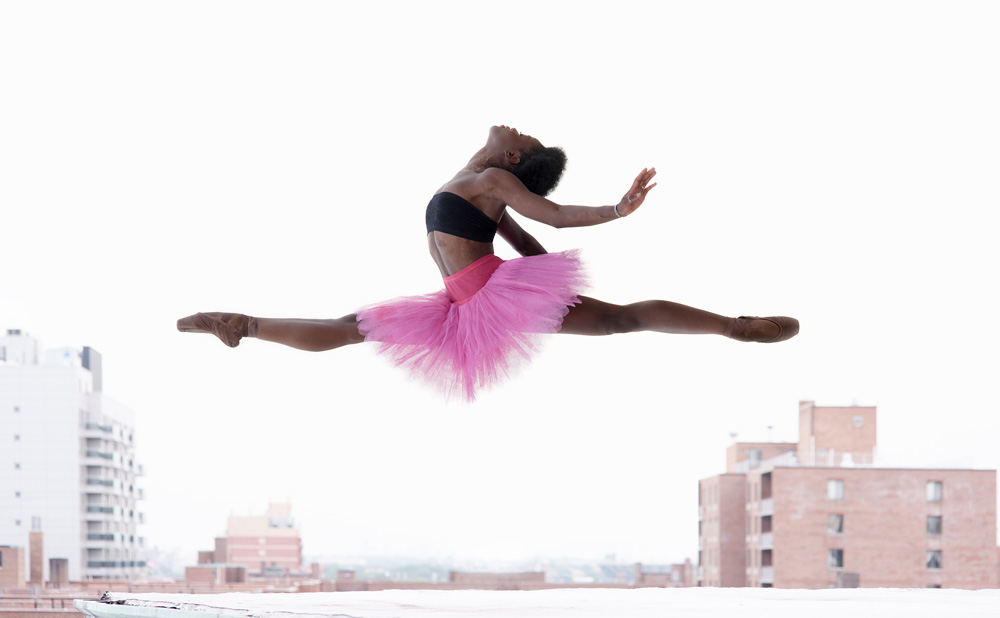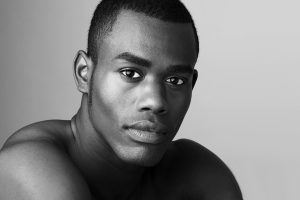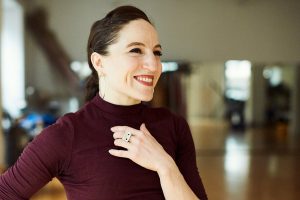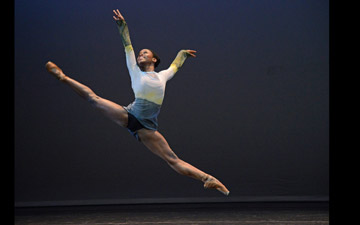
© Jade Young.
Resolute Princess: Michaela DePrince
michaeladeprince.com
www.het-ballet.nl
At only eighteen, the dancer Michaela DePrince has already lived several lives. As a small child, practically a toddler, in Sierra Leone, she lost her parents. Her father was killed by rebel fighters in the civil war that ravaged the country from 1991-2002 (aided and abetted by Charles Taylor, the leader of Liberia). Her mother died soon after. After a year in an orphanage—during which time she witnessed the gruesome killing of her teacher, again by rebel forces—she was adopted by a New Jersey couple, Elaine and Charles DePrince, along with her best friend, Mia. (Her parents, Elaine and Charles DePrince, lost three sons to HIV, with which they had been infected by tainted blood transfusions in the eighties. Elaine DePrince has written about the horror of this experience in her book Cry Bloody Murder). One of the few bright spots in her life at the orphanage was coming across a photo of a ballerina in a glossy magazine. She kept it as a kind of talisman. Perhaps because of that, not long after moving to the United States with her new family—she has ten brothers and sisters, most of them adopted—she asked for ballet lessons.
Soon, her parents enrolled her at The Rock School in Philadelphia, a rigorous pre-professional program, which eventually led to her participation in the Youth America Grand Prix competition in 2010, for which she received a scholarship to the Jacqueline Kennedy Onassis School in New York. (She was one of the featured dancers in the wonderful documentary First Position.) I remember her performance at YAGP that year. Athletic and strong, she practically leapt off the stage. She recently told an interviewer from Dance Spirit that she credits the JKO school with helping her to finesse her remarkable gifts, saying “they’ve shown me that it’s not all about the tricks—about how high your leg goes or how many pirouettes you do.” In 2012, at seventeen, she became the youngest dancer at Dance Theatre of Harlem, and performed with the company on tour and during its New York run. The fine-tuning she received at JKO, and one assumes, at DTH, had clearly paid off. After a performance by the company at the Rose Theatre, I wrote, for DanceTabs: “several of the women, [including] the prodigiously talented (and young) Michaela DePrince, would grace any ballet company in the country.” I now stand corrected: She has moved on, not to another company in the US, but to Europe, where she is currently a member of the Dutch National Ballet’s junior company in Amsterdam. There seems to be no limit to what she can do.
However, it hasn’t been an easy road. In addition to the usual rigors and sacrifices of ballet training, Ms. DePrince has said in interviews that she has encountered racism along the way. When she was eight years old, a promised role in The Nutcracker was eventually given to another dancer because, as she was told, “people aren’t ready for a black Marie.” The rosters of ballet companies continue to be singularly uniform, with the exception of a few like the Cuban National Ballet. But awareness of the problem is growing. Benjamin Millepied recently mentioned his intention diversify rolls of the Paris Opera Ballet when he begins his tenure as artistic director in 2014. (His comments touched off a small firestorm in France, with accusations of political correctness flying.) American Ballet Theatre, the home of the African-American soloist Misty Copeland, has set up a new initiative (Project Plié) that combines masterclasses at Boys and Girls Clubs and scholarships with the goal of increasing access to ballet training. But the road is long.
Recently, Ms. DePrince and I talked about these and other issues. Because of the time difference and her taxing schedule, our exchange took place over email.

© Jade Young. (Click image for larger version)
MH: I’ve read about how, when you were at an orphanage in Sierra Leone, you came across a magazine with a photo of a ballerina. Can you describe the thoughts that crossed your mind when you saw that photograph? Do you remember who the ballerina was, or what ballet was being featured? What did that image represent to you?
MDP: This is something that I haven’t forgotten, probably because it was such a highlight in my life. When I saw the dancer I was most impressed with how beautiful she looked, how fancy her clothes were, what an amazing feat she was performing (she was en pointe on one foot) and how happy and content she was. I think that in my little girl head I suspected that if I could wear clothes like that and stand on my toes, I’d be happy too. I’m not sure what magazine it was. I knew that it was in English and it was old even then.
MH: Where did you grow up, and what was the first ballet you saw?
MDP: I grew up in Cherry Hill, NJ. The first ballet I ever saw was the Pennsylvania Ballet’s performance of the Balanchine Nutcracker. It is also the first ballet in which I performed. When I was eight years old I danced as a party girl and a Polichenelle, one of the little beings that emerges from Mother Ginger’s big skirt.
MH: What made you want to become a ballet dancer, and what has sustained your love of the art form?
MDP: Dancing while you cooked, dancing while you washed clothes in galvanized washtubs, dancing while you waited at the well to draw water…that was a part of the African culture. I loved to dance. I was lithe and limber, so I suppose that when I discovered there was such a thing as ballet, it was a natural progression from African dancing to ballet. The magazine that I found made me want to become a ballet dancer, the lessons that my American parents provided for me and the opportunities they gave me to attend the ballet even as a little girl, probably sustained my love of this art form.
MH: Were you ever tempted to try anything else, or to go to college?
MDP: When I began to swim on swim teams and break league records, I fell in love with swimming as well. As a matter of fact by the age of twelve I had to choose between the two. To become a world-class swimmer demanded hours of practice daily; to become a world-class ballerina required the same dedication and commitment. There weren’t enough hours in the day to make both dreams come true. I chose dancing because I had a passion for it; whereas I only “loved” swimming.
Of course I would someday love to go to college. I graduated from high school with honors. I can begin college at age fifty, but I cannot begin a dance career at that age.
MH: Are there particular dancers you have looked to as role models?
MDP: There are numerous prima ballerinas from world-class ballets all over the globe that I have admired and attempted to emulate. However, my role models were chosen from among the black ballerinas who attempted to open the doors for kids like me. These include Lauren Anderson (Houston Ballet, principal), and Heidi Crux (Pennsylvania Ballet, soloist). Like the civil rights workers of the past, I think that they were very brave in their efforts to change an art form.
MH: When did you discover that you had talent? Who were some of the mentors who encouraged you along the way?
MDP: I think that it was only after years of taking lessons that I realized that I had talent. It was definitely my mother who discovered that I had talent as she watched me mimicking Dewdrop and the Sugar Plum Fairy in my Nutcracker video.
My principal mentors were Stephanie Spassoff, co-director of the Rock School for Dance, Natalya Zeiger, one of my teachers from the Rock School for Dance Education, Franco De Vita and Raymond Lukens with the Jacqueline Kennedy Onassis School at ABT, and Charla Genn, of the Juilliard School.
MH: What are some of the roles you dream of dancing?
MDP: The two roles that I most dream of dancing are the role of Aurora in Sleeping Beauty, and the role of Odette/Odile in Swan Lake.

© Jade Young.
MH: You’ve said in interviews that you’ve encountered racism in the ballet world. Did this take place during your training or in the professional sphere? Was it overt, or beneath the surface?
MDP: I’ve encountered both forms of racism in the ballet world. As a child the more overt racism came from some ballet moms who seemed to be eager to express their opinion about black girls in classical ballet. The subtle racism came from schools, especially from summer intensives, and companies. I’ve observed it and heard about it when it happened to others, and I’ve encountered it myself, though mostly in the professional sphere. As a black ballerina racism is less about what happens to you and more about what doesn’t happen to you.
MH: Based on your own experience, what do you think is keeping more dancers of color from entering ballet and rising in the ranks at ballet companies?
MDP: I think that it is a rare artistic director that is willing to hire a black ballerina and promote her through the ranks. The problem begins with the corps de ballet. I think that artistic directors like the corps to look homogenous. The corps is the backdrop to the story, a forest, a snowstorm, a flock of birds or a field of flowers. One red poppy in a field of yellow daffodils draws the audience’s eyes to the one poppy. However, I don’t think the answer is to cull the poppy. I think it’s to scatter more poppies about the field of daffodils. With more black ballerinas in the corps, there will inevitably be more black ballerinas rising. I think that if these artistic directors or perhaps the boards of professional ballet companies want to draw larger more heterogeneous audiences, they need to be willing to change the look of the corps de ballet.
I suspect that the resistance to raising black ballerinas through the ranks might be due to an old-fashioned way of looking at beauty. Our ideal of a perfect ballerina is based on Russian ballet with its willowy blondes. If a director does not appreciate the aesthetics of African beauty, he will not want to promote a black ballerina to the status of prima, because the prima is supposed to be the most beautiful dancer. She represents the aesthetics of classical ballet, which right now are Eurocentric.
MH: Why did you decide to join Dance Theatre of Harlem, and what was that experience like for you?
MDP: Originally, I auditioned for several classical ballet companies in the United States and Canada. I was only accepted by the Dance Theatre of Harlem. After confirming receipt of my headshot and resume, then traveling by plane to one of the auditions, I was turned away at the door – not give a chance to audition. The company claimed that it had not received my headshot and resume, when I knew that it had.
Though my dream had always been to dance with a classical company, I signed the letter of intent to perform with DTH, which was not a classical company. A few weeks later I was invited to join the American Ballet Theatre. Despite the fact that I was only seventeen and legally could have walked away from DTH, I decided to stay with that company because I believed that it would be wrong to break my promise. I also felt that I had something to offer DTH, and it something to offer me.
MH: Why did you decide to leave DTH after a year [was it a year or was it longer?] for Het National Ballet JC, in Amsterdam?
MDP: I made many friends at DTH, and had great respect for the teachers and artistic staff, but I was four or seven years younger than the next youngest dancer, and some of the dancers were in their thirties. The content of some of the original works was perfect for the older dancers, but too mature for such a young dancer as I, one who was so inexperienced with life. Also I didn’t find the company artistically satisfying. I longed for the extravaganza of the romantic classics and neoclassical works. I liked the contemporary ballet that I danced at DTH, but it had to be interspersed with more of the type of ballet that spoke to my soul.
MH: What roles are you dancing now and how do you like working in the Netherlands?
MDP: I absolutely love dancing with the Dutch National Ballet. Right now I am officially in their Junior Company, but I dance with both the junior company and the main company. I am dancing Diana and Actaeon with the Junior Company, and I will be performing with the main company in Dutch National Ballet’s production of Don Quixote.
MH: What company would you ultimately like to dance for?
MDP: I don’t really know. Currently I am very happy with the Dutch National Ballet. It has a vast repertoire, great dancers, and wonderful teachers and directors. I plan to remain with this company as long as I continue to do well here. Ultimately…? Well that’s just too hard to say. I’d have to have a crystal ball to make that decision.
MH: Did your family move with you to the Netherlands? And if not, is this your first time living on your own? What is that like?
MDP: I have four other sisters between the ages of 13 and 19 who live at home, and my dad works for a company in New Jersey. It would be impossible for my family to move with me to the Netherlands. I plan to visit them often. If I’m not scheduled to dance in late January, I hope to fly home to visit them for two weeks. I boarded at the Rock School of Dance Education in high school, and boarded at a convent in NYC while at JKO, but that was far different than living on my own in another country. I enjoy living in Amsterdam, where I have to do my own banking, shopping, cooking, budgeting, etc. Also, I do miss my family and my boyfriend.
MH: You were recently dismayed by the suggestion, in an interview, that you had left Dance Theatre of Harlem because you wanted to be in a “white” company. The desire not to be limited by race is a perfectly reasonable one. Why did this suggestion strike such a chord with you?
MDP: I felt that statement misrepresented me. I left because I didn’t feel artistically fulfilled. I wanted to dance with a large top tier world-class classical or neoclassical company that had a large repertoire. The fact that such companies are white is unfortunate. However, I feel strongly that it is time for classical ballet to be integrated. As I said earlier, rather than cull the one poppy from the field, scatter more of them about. I feel that by accepting a contract with a company like the Dutch National Ballet, Paris Opera Ballet or any of the other American or European world-class ballet companies I am doing my part, maybe even leading the movement to achieve that integration. Dancing with a company that is considered to be a “black” company will not further that cause.

© Jade Young. (Click image for larger version)
MH: Do you feel that race is less of an issue in European ballet companies than it is in the US?
MDP: No, I don’t see that it is less of an issue, or Ballet Black wouldn’t exist in London, and we’d see more black ballerinas in the major companies. There are few black ballerinas in Europe and none in Russia. I think that in certain ballet companies, the directors are willing to take chances. I am fortunate that I found one of them.
MH: How do you like Amsterdam, and are you learning Dutch?
MDP: I am learning Dutch, thanks to my patient friends. Living in the USA I never saw a building older than 200+ years. In Amsterdam there are so many old buildings. I find it fascinating how the Dutch just keep on repairing them and living there. And of course, I love the fact that I can jump on my bicycle and ride anywhere without the fear of vehicular traffic.
MH: How have the traumas of your early life in Sierra Leone affected you as a person, a dance student, and, now, a professional dancer? Is your past life something you want to put behind you, or do you see those early experiences as an important part of your identity as a dancer?
MDP: I think that the traumas of my early life in Sierra Leone definitely made me a more resilient and more persistent person than I might have been otherwise. However, I feel that my upbringing in the United States had the greatest impact on who I am, and what I do in life. I wish that interviewers would ask me more about my incredible family and less about a part of my life that I would like to forget.
MH: Tell me a little bit about your family, and how it has supported your determination to become a dancer. Families sacrifice so much.
MDP: Despite the fact that I am the eighth of my parents’ eleven children (nine adopted), my dad never begrudged a penny he spent on my lessons, competition fees, pointe shoes or anything else that would help me progress as a ballet dancer. For years he shared the driving to and from Philadelphia with my mom. Besides driving me, sewing costumes, attending recitals, traveling to competitions and providing homeschooling, Mom taught me everything I would need to know to live on my own as a young dancer. I’m a good cook today because I learned from my mom. However, most of all my parents encouraged me when I was down. When I was going through my awkward adolescence they convinced me that I was beautiful, I guess because that is how they saw me. Even now, that I’m 18 and living far away, my parents email me constantly. My mom even writes me funny poems and sends hilarious photos to cheer me up when I am down. She is absolutely hilarious. The dancers I mentioned were my role models in ballet, but my mom is my role model in life.
MH: Do you see you yourself as an African ballerina, an African-American ballerina, an American ballerina, or simply as a ballerina?
MDP: As a person I see myself as an American, but as a dancer, though the world sees me as a black ballerina, I don’t feel that blackness as I dance. When I dance I am strictly a ballerina.
MH: I understand you’re writing a memoir. When will it be out?
MDP: My memoir, which I co-authored with my mom, will be released by Random House in the fall of 2014. I can’t wait to see what everyone thinks of it.

















[…] To read the entire interview, follow this link: https://dancetabs.com/2013/10/michaela-deprince-junior-company-dutch-national-ballet/ […]
What a wonderful, interesting, and inspiring interview. Thank you, to the both of you, from a lover of all things ballet!
Michaela Deprince inspired me to be a better dancer. with my dance teacher and youth ballet we watched first position and i was so touched how her life was and then she became a amazing dancer. one of my dreams is to meet her and become like her i would do anything to do those things.
[…] – https://dancetabs.com/2013/10/michaela-deprince-junior-company-dutch-national-ballet/ […]